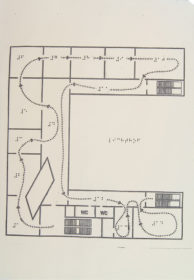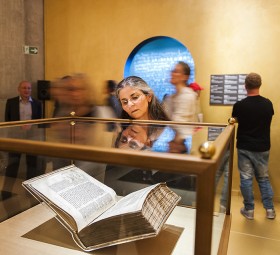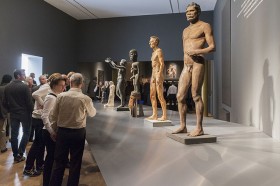A tour for the blind and vision impaired through the exhibition Welcome to Jerusalem at the Jewish Museum Berlin

This tactile model gives an overview of all rooms of the exhibition and explains the way through the exhibition. This tactile model was created by Jonas Hauer like the other models shown in this blog post; Jewish Museum Berlin, photo: Birgit Maurer-Porat
A “museum for everyone,” that is, accessible—that’s what we want to be and to become. The path to this goal is long and sometimes difficult, and it’s not always easy to determine the right direction. New approaches have to be developed, tested, and sometimes rejected. In addition, a wide variety of factors can make access difficult or even impossible for an individual. Sometimes language represents a barrier, sometimes architecture, sometimes the way things are presented, sometimes the topic or perspective, just to name a few.
This makes feedback from our visitors all the more important to us. Their criticism helps us to improve our existing offerings and to make them more accessible. Their praise motivates us to continue on the right path, even against the resistance that we sometimes unfortunately encounter. For this reason, among others, we were very pleased to receive permission to republish the following piece by Gerald Pirner, who was able to open new perspectives for many onto the exhibition Welcome to Jerusalem…
After the entry checkpoint comes the light well. It’s not just the seeing who experience light: an expanse opens acoustically, as if you were stepping out into the open, and yet remained in a closed space. → continue reading
A Conversation about the Exhibition “Obedience”
The exhibition “Obedience. An Installation in 15 Rooms by Saskia Boddeke & Peter Greenaway,” which has just been extended for two months, prompts extremely varied visitor responses. Atalya Laufer and Marc Wrasse regularly give guided tours of the exhibition. They talked to me recently about the experiences they’ve had, how they see the exhibition, and what they believe is at the root of visitors’ reactions.
Mirjam Wenzel: What form do your guided tours of the exhibition take?

Visitor in the “Golden Room” with manuscripts of the three monotheistic religions © Jewish Museum Berlin, photo: Jule Roehr
Marc Wrasse: We don’t so much guide visitors as accompany them on a three-step journey of discovery. We welcome the group and give a brief introductory talk, during which we point out that the Museum commissioned two artists to create the exhibition. Then, together with the visitors, we read aloud the relevant passage of the Bible—incidentally, the translation by Moses Mendelsohn—before leaving them to the exhibition.
Atalya Laufer: I prefer to use the translation by Martin Buber and Franz Rosenzweig.
Marc: But you too use roleplay, do you not, when reading the Bible story? That way, we make it clear that we want to explore the exhibition with our visitors and enjoy a shared experience. → continue reading
I’m not sure what time it is, but it’s already light out. My alarm clock will go off soon. My eyes are already open – the sky is its usual grey. In the space behind my eyes, arguments are going around and around – legal, religious, social, and medical. My tongue doesn’t move but my thoughts speak all the lines of this drama. Right now I’m going around and around on the hamster wheel of an argument that I got dragged into on a tour I gave the day before of the special exhibition “Snip it! Stances on Circumcision.” Every time I thought I had explained to this visitor the profound differences between ritual circumcision of boys and female genital mutilation, she would bring us back into an argumentative spiral.

Visitors in the exhibition room “On the Knife’s Edge” © JMB, Foto: Jule Roehr
Despite Cilly Kugelmann’s assertion (see the German-language introduction of the book publication, downloadable on our website) that we don’t want to use “Snip it!” to continue the 2012 debate about ritual circumcision; despite an exhibition that addresses, above all, the cultural and historical background of the ritual; despite my careful presentation in the tours, where I aim to encourage visitors to really see and understand, and not to judge and argue; despite the many visitors who embrace my suggestions with great openness and interest: → continue reading


